The Music Man Sabre
A new friend has joined my stable. A pricey addition to the wall, but it is worth every penny.
Two weeks ago, I received the slightly used Ernie Ball Music-Man Sabre in Moonstone Blue. I wrote about my short flirtation before in this post:
Alas, I did open my wallet, and $2,600 later1 (plus shipping and tax) it arrived on February 1.
It was used, but apart from some fingerprints on the finish of the body, it was as if I bought it fresh from Sweetwater.
I had exchanged some messages with seller, and he had restrung it with 9.5 gauge strings, but otherwise it was as it shipped from the Music Man factory.
It arrived in the Mono soft-shell case that is remarkably sturdy, and with all the usual “case candy2” and the strings were completely detuned, a best practice to prevent damage to the neck.
I clipped on my tuner and tuned it up to pitch (a standard 440 A) and I put it though its paces.
A digression - and comparison to “good” budget instruments
Here’s where I need to spend a couple of minutes talking about the differences between a $300 guitar and a $3,500 guitar. I have several budget guitars from Harley-Benton, all of which I spent between $350 and $400 for. They all have stainless steel frets, two of them have roasted maple necks and one is a neck-through design. They are fine guitars, and they play perfectly. One of them needed a fret polish, but the other two were just perfect out of the box. I have done a few set up tweaks to make them play the way I like, but in general, they punch well above their weight.
But they are made in a plant in Indonesia (probably the Cort factory) and they are made in large quantities. As such, they are damn good, but not perfect.
But this Music Man was built at the Music Man factory in Sam Luis Obispo, California. The base build out of the guitars uses much the same equipment as the Indonesian factory, planers, CNC machines, and the like, but the difference in the build quality and the fit and finish is night and day. The Harley Bentons are great guitars, but the material and workmanship of the MM is just otherworldly.
On to the guitar
First, the guitar is a carved top, with a thick figured maple cap glued on top of a Okoume body. The thick flamed maple cap extends out to the edges and the edges are unfinished, giving it the appearance of having wood binding:
The top is a nicely flamed maple that is book matched.
The pictures do not do it justice. The flames are accentuated by the blue stain with a dark “burst” at the edges to give it some depth. But the gloss is very high, and that is the result of many coats of the clear coat that have been buffed out in-between coats. The net result is a very deep optical finish that you can get lost in.
The neck has an ebony fingerboard on top of a birdseye roasted Canadian maple that is finished with a custom blend of gunstock oil and wax. They are very proud of this custom finish, and they are right to be so. It is unbelievably smooth and easy to play, sliding up and down the neck is effortless.
The neck profile is a skinny modern C3, thinner than my H-B’s, but very similar in feel.
The fretboard is a 10” radius, a little more curved than my preference, a 12” radius, but I really don’t mind. In fact I barely notice it. Must be the neck shape and the radius combined to deliver a superior left hand feel.
The scale length is 25.5” like the standard Fender (Gibson’s are 24.75”)
The net-net is that the guitar plays like butter, is close enough to my preferred 12” radius that I don’t notice the difference.
The fret ends are perfectly dressed and finished, and — as one would expect from a $3,500 guitar — polished to a mirror finish.
The headstock is a defining feature of Music Man guitars. Instead of the tuners (machine heads) being either in a row, or 3+3, they are in a 4+2 configuration. This allows a shallow angle to the nut, and uniform tension. The benefit is outstanding tuning stability, and not needing a locking nut to maintain tuning when using the tremolo bar.
Oh, and the tuners? They are locking Schaller tuners, a top quality brand, and looking at Stew Mac, a set will run you nearly $300. Again, a premium set of components on a premium guitar. You get what you pay for!
The other end of the guitar is the bridge, in this case it is a tremolo block designed and built by Music Man. It uses bent steel saddles, and it currently is set to just barely float (that is offer some tension increase as well as to slacken the strings. The body isn’t routed to give you the full Eddie van Halen effect, but frankly, this setup is more to my style of playing.
There is a shield that makes it super comfortable to rest your palm on. The tremolo is a 2 point with a knife edge on the fulcrum for no friction. Super smooth, and it stakes in perfect tune. Oh, and the intonation? It was perfect out of the box.
The pickups deserve some mention. They are wired in house, and they are clear, bright, and have plenty of output.
In the 1990s, EVH was working with Music-Man to build a guitar for him, and they wound up a bunch of different pickups to please Eddie’s discerning ears. At the end of the exploration and experimentation, they were down to two pickups, and the one that Eddie didn’t choose is the same specs as MM dropped into the Sabre.
Frankly, it sounds freakin’ phenomenal. Bright, high output, but if you roll off the tone and the volume, there are tons of nuance. Regardless of what I want out of it, an edgy hard rock, a ballsy blues tone, or a soft jazz sound, it is trivial to dial in.
The electronics are smooth, the pots are top quality, and even the output jack is one of the most solid I have ever seen. Just top tier quality across the board.
How does it play?
Whatta ya think? It is, in a word, perfect.
The neck is super comfortable, and smooth to play. The frets are medium jumbo, and super easy to chord, or to bend strings. No dead spots, and the action is about 3/64’s of an inch. Not too low, not too high. Just right.
The 5 way switch provides many configurations of the pickups, series, parallel, and combinations of the neck and bridge.
While I am not a huge tremolo bar user, I did insert it and do some whammy work. The guitar stays in tune better than my Charvel with the Floyd Rose.
The nut is compensated, so the little tweaks of the 0th fret help even the temperament of the tuning (this is akin to the Buzz Feiten system).
Oh, and tuning stability. It took about 3 days for the guitar to acclimate to my local conditions (it shipped from Tennessee) and since then, I have not had to touch the tuning. No drift, no waver, nothing. Some of that is the locking tuners, and some of that is the consistent angle at the nut. The net result is just rock solid tuning stability. Seriously, every day I put my tuner on it and check, but after the first couple of days, no adjustments have been needed.
Wrapping it up
Let me be crystal clear: you do not need an instrument of this caliber to make great music. Every one of my Harley Bentons that cost a fraction of what this Sabre cost plays amazingly well. But if you can swing it, and it isn’t a purchase that would imperil your finances, I can assure you that your eyes, your fingers, and your ears will enjoy this splurge.
I am blessed that I could easily afford this, but it is overkill.
That said, I am extremely glad that I pulled the trigger. I get a big shit-eating grin. This is a keeper, and the mythos of Music Man is true. The quality of the components, the care and craftsmanship, and the fit and finish are top notch. For a standard, catalog item guitar, it is a bargain at its price, and even had I not shaves $800 off the retail price, I probably would have spent the money.
The only thing I added was a guitar strap. Perfection!
This is something I will carry with me until I draw my last breath.
Gulp, that is a lotta cheddar
Case Candy is the tags and paperwork that accompanies a guitar as new. Not a must have, but it does indicate that the prior owner is a cautious person who preserves the littlest details.
As with many things Guitar related, this is a reference to Fender’s shapes. Google fender neck shapes and you will get plenty of details. But the modern C is pretty much standard these days unless you get a vintage reissue or a custom shop.



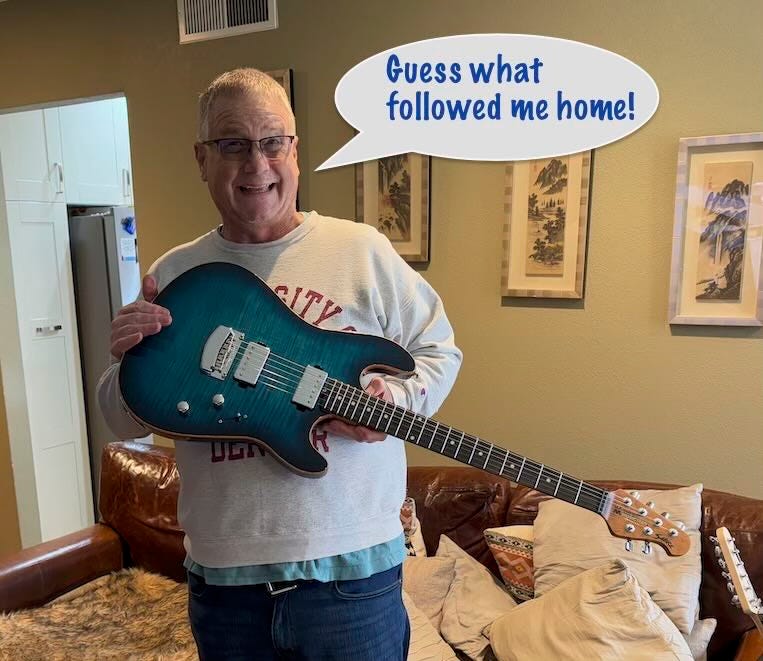
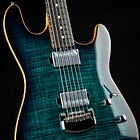

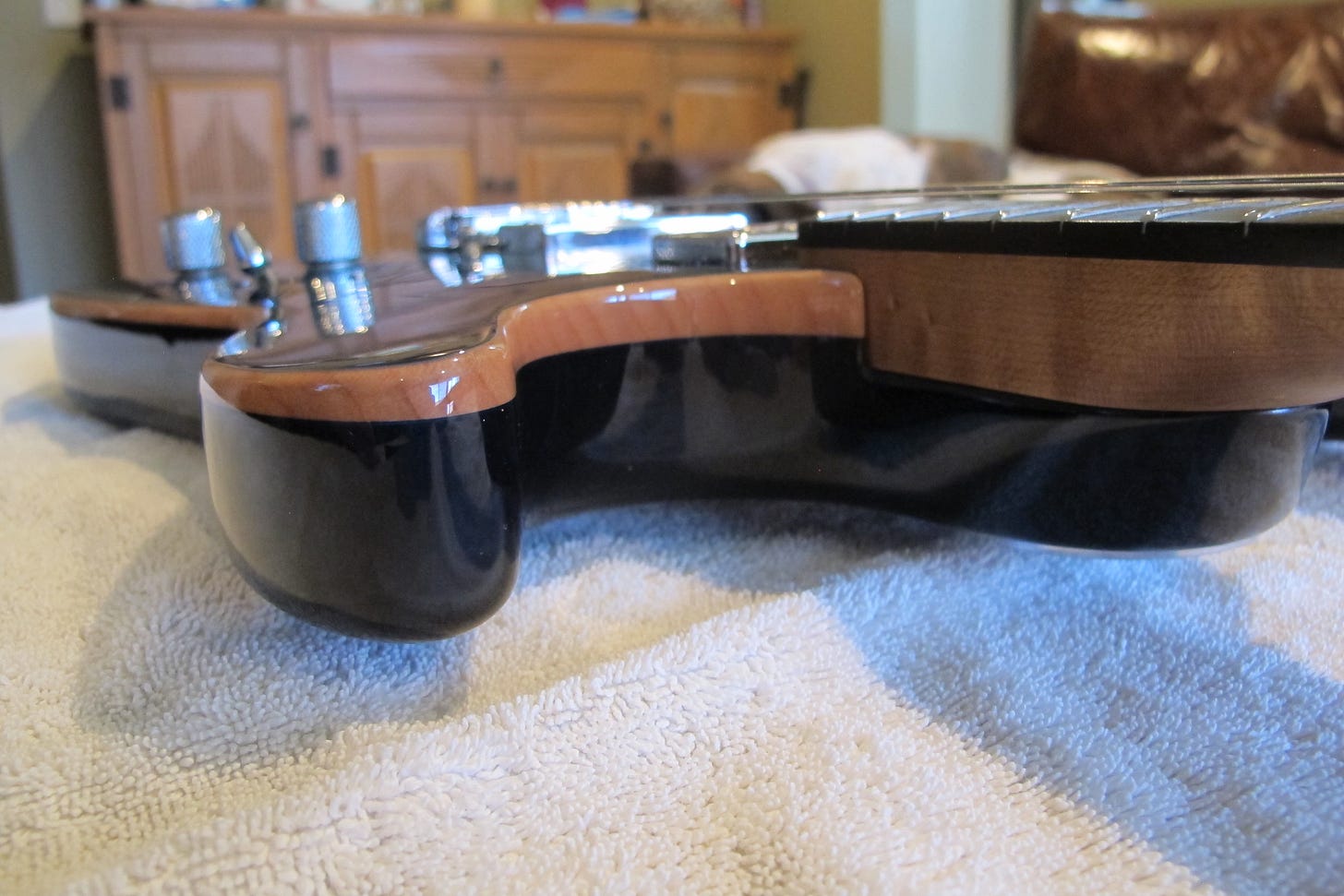
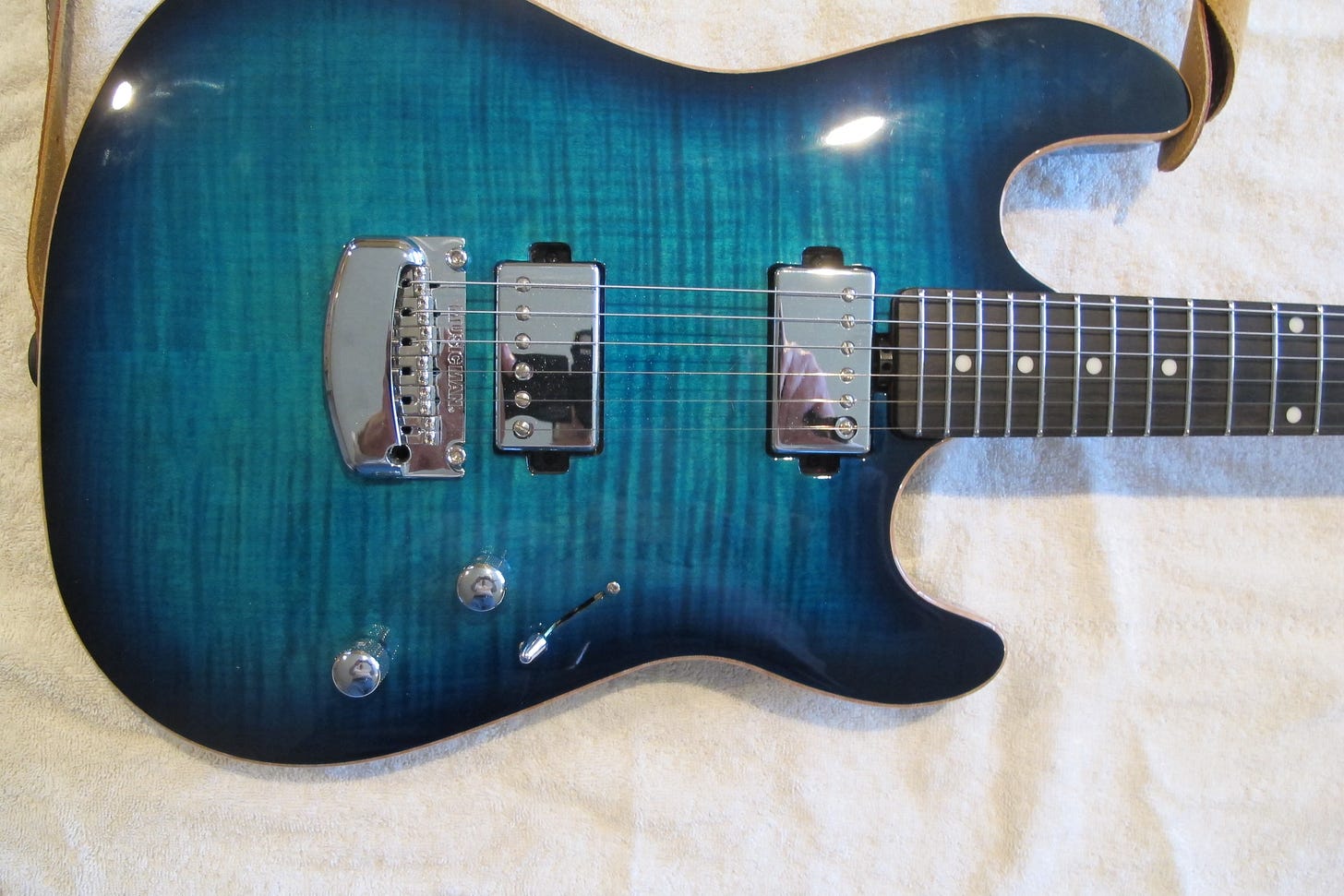



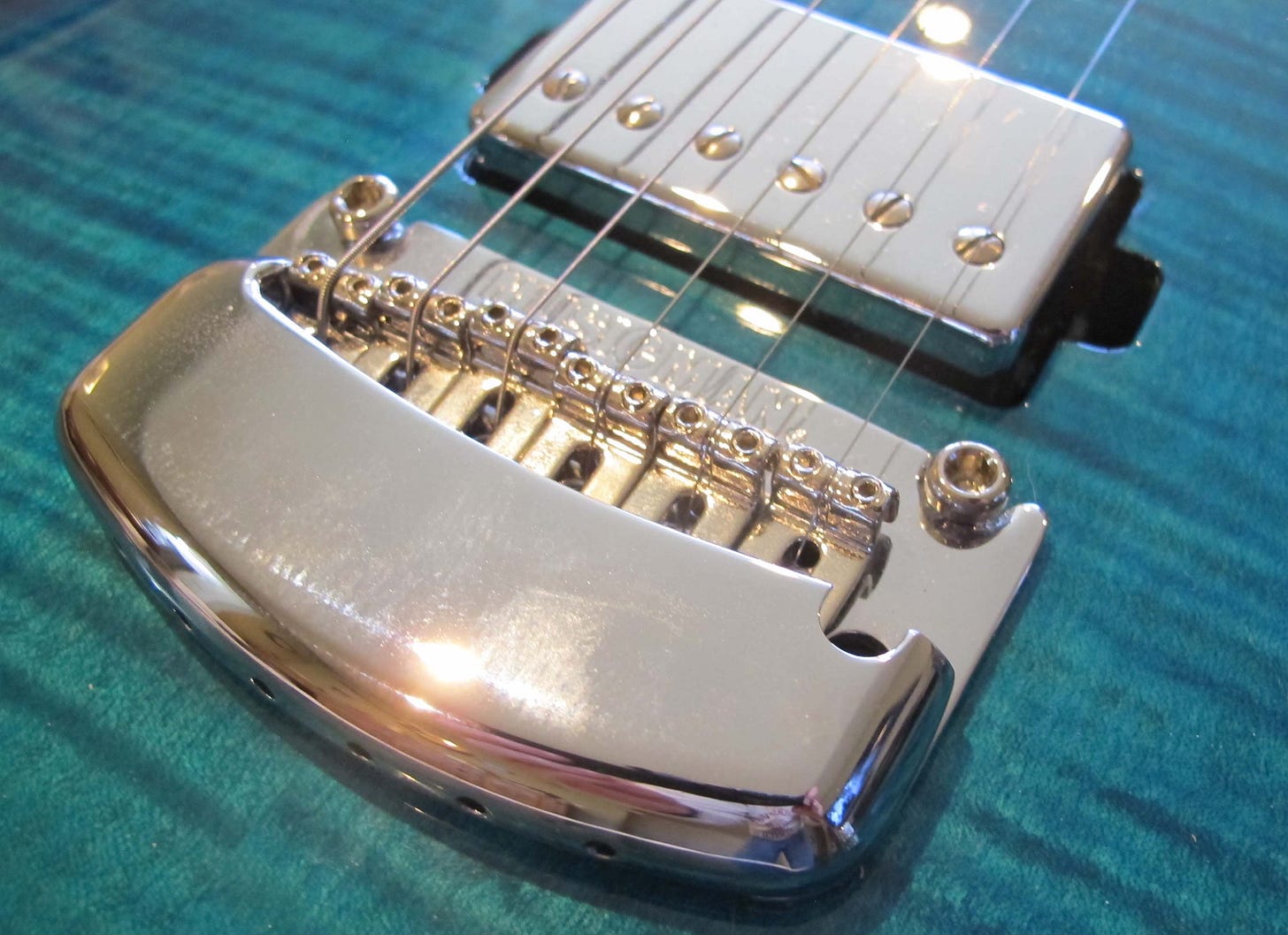

A functional work of art! Thank you for the guitar primer on craftsmanship. She (?) is a beauty! My guitar proficiency was 3 chords, from which I could play (badly) a number of songs. Is there a video clip of you playing one of your works of art in our future? 😉
I was fretting writing this pun and I won’t string you along but guess who strung along home with me?